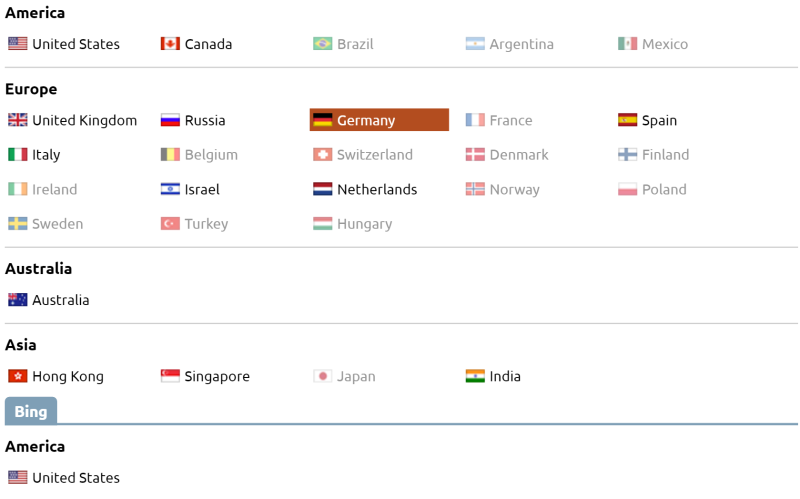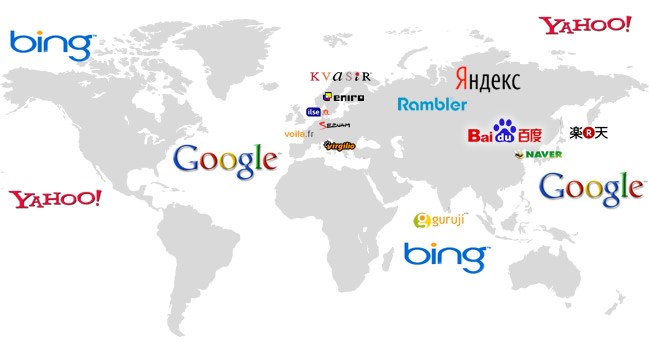
Did you know that only one-seventh of the world’s population speaks English? And only about 340 million speak it as their first language (source: Ethnologue). That leaves more than six billion people who won’t get the message if you have the English-only mindset.
If you sell a product or service that’s available worldwide, localizing your content online can be a massive opportunity, especially if your website is close to maxing out its current SEO potential. SaaS is a good example of an industry that can benefit from this; they can serve customers around the world at no extra cost.
Well-known online marketer Neil Patel claims to have increased his traffic by 47 percent by translating his blog into multiple languages. When you think about how big the world market is, those kinds of results aren’t unreasonable to expect.
For the purpose of this article, I’m talking about going international for SEO, but the same opportunity applies across paid search and social media.
There are two ways to target international queries for SEO:
- Through simple multilingual targeting. This means making an alternative version of your website in another language. This will cover that language in its entirety, across all geos. For example, you may have a Spanish version of your website at es.website.com with the tag: hreflang=â€es†(Not sure what hreflang is? Read up on it here).
- Through international geotargeting. This means making alternative versions of your website based on the region. You don’t necessarily have to translate your website to another language to target other regions. You can have a default (x-default) English website, with alternatives in Canada (en-ca) and the UK (en-gb). Or you can have a default English website, with Spanish alternatives in Mexico (es-mx) and Spain (es-es).
Check out the source code of Freelancer.com if you’d like to see an example of a website that goes all out with internationalization.

From personal experience, I know that going global is a massive opportunity for SEOs. I’m Canadian, and I ran a very profitable e-commerce website by ranking it for terms that would have been impossible to compete for in the US but were relatively easy to rank for with a .ca domain. That being said, throwing up a bunch of international versions of your website most likely won’t have the impact you hoped for.
Just like most things in life, in order to reap the benefits, you need to do it right. Here are five considerations you should consider if you’d like to benefit from global SEO:
1. Have you done your research?
Are you sure that your product or service is wanted in other regions or languages? It’s vital that you do your homework before you decide what your game plan is. A good starting place is to look at the Location and Language tabs under Geo in Google Analytics.

What countries and languages are converting right now? You may be surprised to see a country like Romania converting well, while bigger countries like Germany are near the bottom. Don’t assume that bigger is better!
Also, take a peek at your competitors to see what languages or regions they’re targeting. An easy way to do this is to look for the hreflang tags in the source code of their website. You can also pop their website into SEMrush and look for highlighted countries to find regions they’re ranking in.

If you’d like some more hot tips, SEER has put together a fantastic guide on creating an international SEO strategy. Doing good research up front can be the difference between a successful international SEO campaign and a big flop.
2. Is your website ready?
Before you go international, ensure that your current website is optimized for search. It’s relatively easy to translate a website that’s properly formatted and ready to go.
You don’t want to duplicate errors across new pages or localized CMS installations; that just multiplies the work you’ll have to do to fix them. Cross your t’s and dot your i’s with your current website before you consider internationalization. (If you’re just beginning to learn SEO, I’d stick to one language until you get some traction and learn the ropes.)
If your website is up to snuff, think about how you want to structure your website for international content. The main decision you have to make for each language/country is ccTLDs vs. subdirectories vs. subdomains. SEMrush has put together the best guide I’ve found on this topic, so take a look.
Also if you don’t have the resources to translate your entire website, it’s not a necessity. Here at AgencyAnalytics, we’ve decided to create a single landing page — that includes all key info — which we can replicate easily across our target languages. (See our Dutch landing page as an example.) It allows us to target valuable SEO keywords in many languages and gives us a good landing page for PPC.
3. Can you find the right people?
You know the on-page SEO basics, right? TL;DR: Build your page around one main topic, include semantically related keywords throughout the copy, and ensure that your meta data is optimized.
This process is just as important in other languages as it is in English. If you pick keywords that don’t have enough search volume or that you can’t possibly compete for, you won’t drive traffic to the website.
Obviously, you won’t be able to write and use your SEO expertise in every language. This means you’ll need to hire an agency which specializes in search-optimized translation or find the right translators.
Don’t assume that translators are as knowledgeable as you are. When I post translation jobs, I ensure that they have experience doing keyword research, understand the basics of SEO and have the ability to translate an AdWords campaign. Seeing as you don’t speak those languages, it’s important to find the right translators or agencies who will get the job done right.
Also give some thought to customer support. You’re going to be getting new customers in a variety of new languages and locations. Some customer support apps like Zendesk have machine translations, or you can configure the API at Gengo to work with your support platform. If you offer phone support, you may have to hire support in other languages or make it clear on your website that support is only in English.
4. Are you only looking at Google?
If so, it’s a big mistake. While Google is the world’s most popular search engine, there are many other players out there.
Some of the most populous countries in the world favor other search engines: China has Baidu, Russia has Yandex, South Korea has Naver, and Yahoo has a 40-percent market share in Japan.

Image source: Webcertain
There are three main reasons I bring up alternative search engines:
- You have to ensure that your translators do keyword research on the proper platform. For example, if you’re looking to market to consumers in Russia, ensure that Yandex Wordstat is used instead of the Google Keyword Planner.
- Each search engine runs on a different algorithm, which means that they have different ranking factors. Do your research on any search engine you plan to rank on. Some may still have a recommended keyword percentage in content, some still use meta keywords, and others count social signals as a ranking factor.
- Ensure that you’re marking up your website correctly. While Google and Yandex support hreflang annotation to determine what version of the page to serve, Bing does not. The same may apply for other search engines.
5. How are you going to build links?
A word of warning: Building more pages splits up the link equity to your website, which can actually hurt your rankings. If you expect to double your traffic by translating a 1,000-product e-commerce site and adding a link at the top, you’re in for a surprise. You can end up losing traffic to your website.
This varies from site to site, but have a solid link strategy in place before you duplicate your entire website. Find ways to build links from the country or language you’re localizing to in order to see good results. Maybe think about using your translators to do some link building for your new pages.
This also ties into the ccTLDs vs. subdirectories vs. subdomains debate. If you have the resources, starting with a new ccTLD will be harder to rank in the beginning, but it may pay off in the end. Otherwise, you can leverage your current domain authority by making landing pages for other languages and countries via subdirectories.
Conclusion
When you think about the potential, going global with SEO may be your biggest opportunity to gain more traffic and sales. It can be a tricky proposition, especially for large websites, but the return on investment can be enormous if you pull it off correctly.
Take my five considerations into account, read all you can on international and multilingual SEO, and get cracking!
Some opinions expressed in this article may be those of a guest author and not necessarily Search Engine Land. Staff authors are listed here.
About The Author
(Some images used under license from Shutterstock.com.)
Article source: http://searchengineland.com/global-seo-huge-opportunity-5-tips-success-248253
